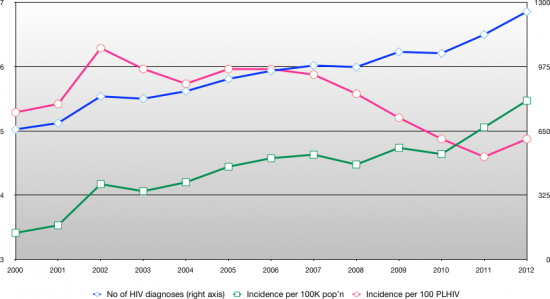Lots of discussion over the last couple of days about the recently released annual surveillance report for HIV, which shows a big jump in the number of HIV notifications for the last year, especially in NSW. Obviously any rise in HIV is concerning and I’ll leave it to the experts to debate the likely causes of that rise, but as I have previously argued, a seemingly important measure of the infection rate remains unreported.
Three years ago, I argued that HIV infections aren’t going up, they’re going down – if you consider that the number of new infections must be a function of the number of people living with HIV, the picture over the last few years is starkly different. I’ve updated the data from that post in the chart below (click it for a larger version):
The pink line on the chart shows the number of new diagnoses per 100 people living with HIV, based on the Kirby Institute data. There has been a noticeable increase in that measure over the last year but this follows a long period of decline from a high in 2002 of 6.29 to a low in 2011 of 4.60 (incidence per 100 PLHIV).
My argument here is that, whenever an HIV infection occurs, one HIV-positive person is the source of that infection, and as the number of people living in the community with HIV rises, some rise in the total number of new infections is inevitable. The picture over the last few years shows that rise has been lower than would be predicted by the increase in the HIV-positive population alone, which I think is a strong sign that HIV prevention efforts have been working.
The increase in the last 12 months – from 4.60 to 4.87 (incidence per 100 PLHIV) – represents a 6 percent rise in infections, and while that’s lower than the 10 percent rise in the raw numbers, it’s definitely worrying. But it’s a single data point and we won’t know for a year or two if that is the beginning of a sustained rise or just a blip in the trend.
It’s understandable that researchers, government and the media are troubled by the annual jump in new infections (and it has been an annual event for many years now) but, as long as positive people are remaining healthy and sexually active, at least part of that rise is directly explained by the increase in the population of people who are available to be the source of new infections.
The usual caveats apply: I am neither an epidemiologist nor a statistician, and the only data I have to work with is that published in the surveillance reports. Happy to be corrected on any of the data or to be (politely) disagreed with as to my interpretation of it.

They figures are going up because the prevention material is pissweak, and totally ignored. The figures are also going up because the ball hasn’t been picked up on meth. 9 out of 10 meth users don’t know it causes strokes. And 10 out of 10 wouldn’t know it causes it micro strokes with every single usage. Let’s see that on a poster in block letters. But of course it will never happen because we mustn’t offend or scare or alienate anyone. Hence marketing which achieves nothing, except in the carefully crafted figures that sit in annual reports. Ever seen anyone even glance at an HIV poster in a sauna in the last 10 years? No hard messages. No emotion. Zero impact.
I am not sure I entirely follow you, however on the following points:
“My argument here is that, whenever an HIV infection occurs, one HIV-positive person is the source of that infection, and as the number of people living in the community with HIV rises, some rise in the total number of new infections is inevitable.
>>> How much is “some” rise? This depends on transmission that can be affected by prevention but also by higher level of testing and therefore entry into care, and more HIV-infected individuals with an undetectable viral load and therefore not infectious.
“The picture over the last few years shows that rise has been lower than would be predicted by the increase in the HIV-positive population alone, which I think is a strong sign that HIV prevention efforts have been working.”
That is true only if we accept a direct correlation between number of HIV infected and number of new infections. This correlation has not been observed. It may be due to prevention working or to treatment of the HIV infected population working as prevention as shown in KwaZulu Natal where a 30-40% coverage was enough to show a decrease in the number of new infections.